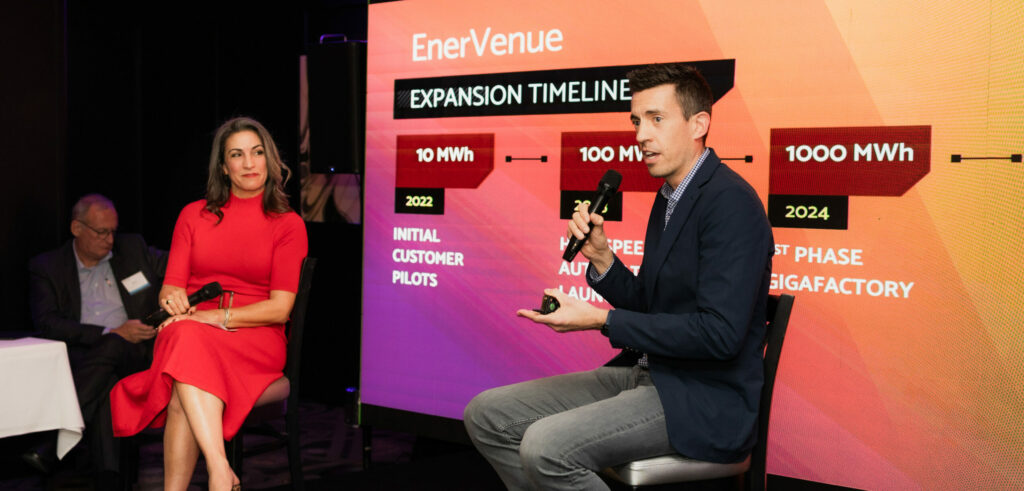

The Barrel of Tomorrow Climate Tech Cocktail Reception
Friday, January 27th 2023Meade Harris, Co-Founder of Dynamo Energy Hub, and Brent Smelter, Head of Business Development at BloombergNEF kicked off The Barrel of Tomorrow Climate Tech Cocktail Reception. Jon Moore, CEO at BloombergNEF lent his expertise, and welcomed the guests to this pertinent event. Meade introduced Dynamo, and the importance of connecting with fellow leaders in the energy sector.
Sarrah Raza, Technology and Innovation Associate at BloombergNEF provided an overview of the climate technology investments tracked over 2022. Sarrah offered a sneak peek into BNEF’s annual Energy Transition Investment Trends Report with data tracking investment in six mega-sectors: transport, energy, agriculture, industry, buildings, and climate/carbon. In 2022, funding across the board for these sectors reached a whopping $59 billion, which is a 3% increase from 2021. Energy and transport have continued to remain the largest sectors of investment, receiving 80% of all funding. Raza discussed the significance of studying the year’s investment trends, especially as we go into the new year and predict the trajectory of energy transition trends.
Kristin Barbato, Co-Founder at Dynamo Energy Hub, moderated and led a discussion with six key speakers from leading startups with solutions to the composition of the “Barrel of Tomorrow.” The discussion started with Peter Quigley, CEO of LoCI. LoCI implements systems for emission control and management, capturing methane production from landfills. Peter explains that the largest single source of greenhouse gas emissions are methane emissions. “This is the key bridge to lower emissions in the short term to buy time to do something more difficult, more challenging, with decarbonization initiatives,” Peter informs, encouraging attendees to give more attention to methane emissions which are often overlooked by carbon dioxide emissions goals.
Ram Ramprasad, Chief Commercial Officer of Twelve, explains carbon transformation, and electrolysis systems that the company implements. Twelve is able to extract carbon from carbon dioxide, instead of extracting it (harmfully) through fossil fuels. The process being emulated is one we are all familiar with, photosynthesis, but on an industrial scale. Twelve has just launched its production of clean jet fuel, revolutionizing modern travel for the clean energy economy.
Blake Manuel, Senior Vice President of Cemvita Factory Inc., joined Kristin next to talk about clean hydrogen solutions. “Cemvita Factory is an industrial biotech platform company,” Blake says. The company aims to create an economical and sustainable solution, turning carbon dioxide from flue gas into liquid (to be used as diesel), and by using microbes to produce hydrogen. In 2023, Cemvita is overcoming the negative connotations many companies associate with biological solutions to the energy crisis, and will continue to build a more robust platform to bridge research to commercial companies and resources.
Glen Bailey, Vice President of Carbon Clean, followed with discussion of carbon capture and storage. Bailey explained that Carbon Clean is a global leader in industrial carbon capture, offering cheaper solutions and reducing their footprint. A solvent that picks up carbon dioxide as emissions from a plant is used for the carbon capture; the aspect unique to Carbon Clean is the sizing and location of these carbon capture systems. By sizing down the systems, the cost of the process comes down as well, allows for broader applicability, and drives down the footprint of companies’ operations.
EnerVenue’s Associate Director Chad Spring informs attendees of the next generation of battery technology, offered by the company. Unlike most batteries, which are Lithium-Ion batteries, this nickel hydrogen battery has no fire risk, minimal operating expenses, low maintenance, and competitively low total cost of ownership. The company was originally created by NASA, but faced difficulties with the price of the product. In 2017, Stanford remodeled the product, removing expensive components such as Platinum, catalyzing the company’s newfound success.
The final panelist of the evening, Preston Bryant, Chief Executive Officer of Momentum Technologies, showcased the company’s Lithium-Ion battery recycling technologies. Momentum works with companies that collect batteries, and processes those batteries with a “breakthrough innovative technology called membrane solvent extraction.” The process separates the high-in-demand-metals, and sells them back into the market. This process differs from other “recycling” plants which only smelt down the metals, and is not as productive. The costly, and hazardous process is made easy by Momentum by using membranes made by 3M, pulling out Copper, Nickel, and Cobalt, at a small scale so the technologies can be located at the battery source. The metal used in batteries can therefore have an “infinite life afterwards,” saving them from being wasted or needing to extract more metals.
The future of climate technology has never been so exciting. This conference showcased only a sampling of the many progresses and systems being further developed, and we look forward to what tomorrow holds not only for these very promising startups, but for the energy sectors as a whole.
For media relations contact
Claudia Prandoni Marketing & Communications Manager